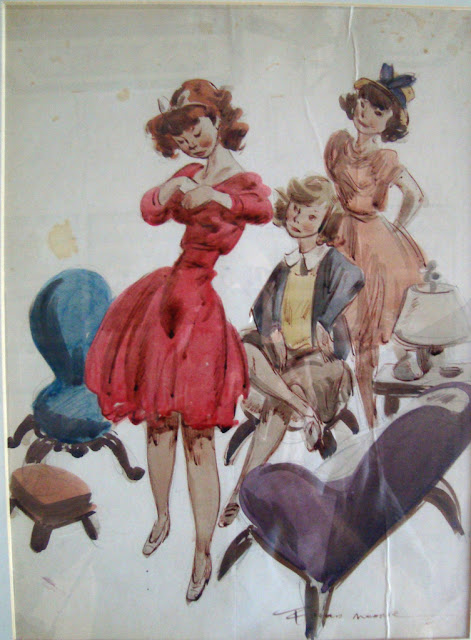For some reason I have a difficult time finding those attributes in recent as well as upcoming animated feature releases.
Look at how Donald Duck's world was presented in this 1944 ad. So incredibly charming and inviting. You can't take your eyes off this -I believe- Hank Porter illustration.
I could give you hundreds of other examples from the past that tell me something is missing in today's animation offerings. Not that I expect animation today to look like 1940s Disney. It's just that there was integrity and artistry to cartooning. A higher standard!
I am reminded of what Joe Grant told me, what seems like just a few yers ago: "We had the same problems making animated movies back then. It's just that we drew better."
I could argue that the advent and influence of video games has been toxic on animated features from an artistic point of view. Call me crazy, but I kind of believe that.
Yet box office success speaks for itself. Like someone said: "You can't argue with money in Hollywood."
Anyway, tons of appeal in this James Bodrero sketch for FANTASIA.
The master of appeal, Fred Moore.
I remember that these were the first Disney animation drawings I saw as a kid. This photo of Kimball was included in a small brochure that came with a Disney Super-8 film clip.
I kid you not, my heart was racing. Magnetism on a grand scale.
I am confident though that eventually more artistic "left-turns" will be made in animation.
Art has a way.....





Hi Andreas, I'd be interested to hear your opinions on how video games have influenced animated films. If this is indeed the case, I wonder why exactly Hollywood is taking cues from games.
ReplyDeleteThe reverse is definitely true - Hollywood is influencing video games. Storytelling in games is maturing more and more at the moment, and is using lessons from film to help it.
I just watched a recent animated feature (non-Disney) on Netflix and was struck by how poor the animation was. Character design was sometimes good, but the animation? Yikes! Yes, it was very similar to the quality of a video game, I thought at the time. The blame must fall, at least partly, on the CGI process. Shading added via computer program gives even the worst animation a slick look that, IMO, disguises the poor animation the same way I hid the flaws in all my art school projects with heavy shading.
ReplyDeleteWell said.
DeleteThe problem as I see it is that there is so much bad animation out there that I'm not sure the general public knows any different anymore. And so production companies, whether in film or in games, just aim for 'passable' because they don't see value in doing better if nobody watching actually notices the lack of quality. Individual animators do their best I'm sure, but I have no doubt that studios don't employ the best animators and they don't give them the time needed to produce excellence. That's a generalization, but a valid one, I feel.
DeleteNice Post Thx เกมออนไลน์ใหม่ 2019
ReplyDeleteI think cheap animation meant for TV was detrimental to animation quality -- low frame rates, characters often holding still apart from maybe a mouth movement.
ReplyDeleteI remember watching a recently made Looney Toons cartoon, maybe 10 years ago, and it was stunning how little movement the characters had compared to the classic old ones. There was a scene with no actual movement at all where one character was being ignored by another, but instead of the action of ignoring (as would have been done in the old) it was inaction.
I don't play video games enough to know what kind of influence those had, but also Anime has had an impact on 2-D. Anime can be absolutely gorgeous, but it likewise is based around more of a stillness. Some of it, I suppose, comes of Japanese culture discouraging largeness of movement and emotional displays, so that carries into the cartoons -- and then, into what people are used to seeing in cartoons.
I don't know if 2-D will really come back as it once did. Seems like on par with knowing how to illustrate in taille-douce. There's a certain artistic merit to it and certain people will learn it for historical or reenactment or special artistic reasons, but it's never going to be mainstream again.